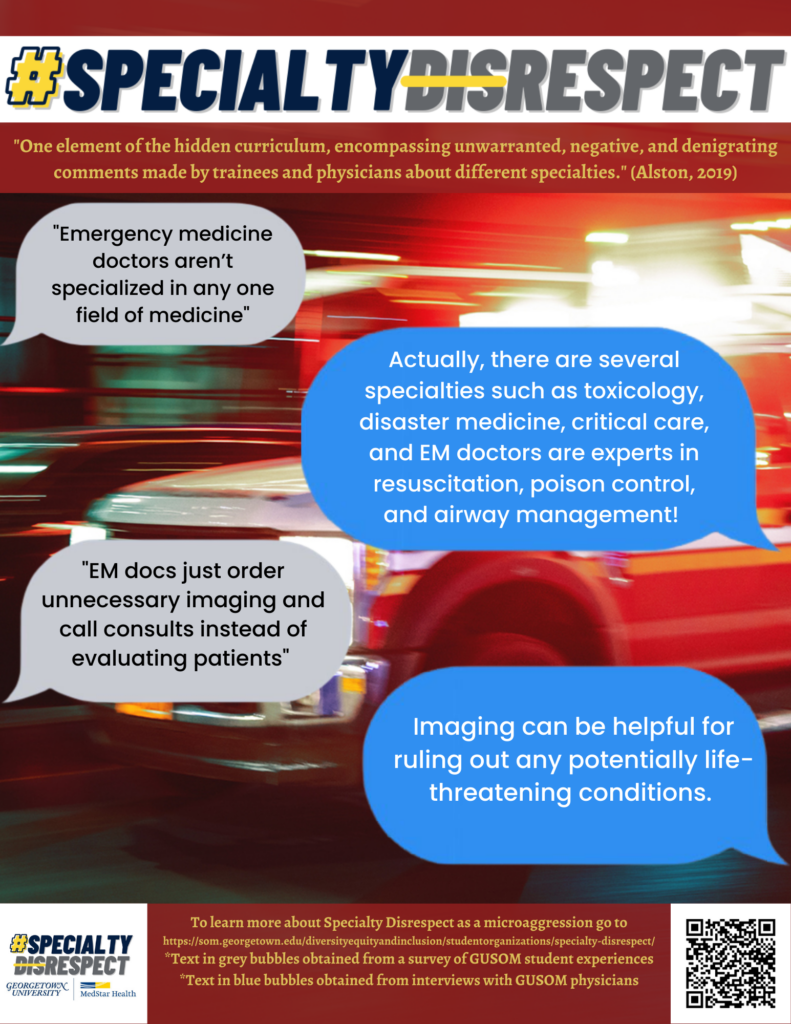Emergency Medicine

Fiction #1: Emergency medicine admits everyone to the hospitals and doesn’t know how to deal with any non-emergencies.
FACT: Emergency physicians provide medical treatment to patients requiring acute and life-saving care. They must have a medical degree, complete a residency and obtain the proper licensing and credentialing. Emergency physicians’ primary job functions are to resuscitate and stabilize patients and transition care to an appropriate endpoint. (1)
Fiction #2: “Emergency medicine is for people without attention spans/for people with ADHD”
FACT: This myth comes from the fast setting of emergency medicine. Emergency medicine doctors handle multiple patients at once. They must be able to think and act quickly to make a tentative diagnosis and determine the appropriate course of treatment. They need to quickly triage patients as they come according to their symptoms — life-threatening conditions take top priority. Nevertheless, emergency medicine allows for a variety of different personality styles. It is important to be comfortable with acting in the face of uncertainty, with multitasking, with thinking clearly in the face of sensory overload and having good communication skills. These are not things you need to be born with — that is why there is an intensive residency training process — but you have to be interested in training these skills. (2)
Fiction #3: “Emergency medicine does not offer a good quality care”
FACT: Urgent care centers are staffed with doctors, nurse practitioner, and physicians who have years of experience working in emergency medicine. When you visit an urgent care center, you can be rest assured that you will be seen by a doctor, nurse practitioner or a physician assistant. (3)
Fiction #4: “Emergency medicine doctors don’t care about their patients”
FACT: Emergency physicians can have intense meaningful interactions with patients and families — often on the worst day of their life. There still is an art to this practice of medicine. According to several EM doctors it is immensely satisfying to do it well, and it also is incredibly humbling. (4)
Sources
1. What are the duties of an emergency medicine physician? ApolloMD.
2. What is an emergency medicine doctor? WebMD.
3. Urgent Care Myths vs. Facts. Instant Urgent Care
4. Myths about ER doctors: true or false? David Geffen School of Medicine.
Read the text version of the poster
[Background in color is image of ambulance driving past]
[Top header in red. Text in yellow]
“Specialty Disrespect” in bold at the top. Underneath this title reads “Specialty Disrespect (SD) is an element of the hidden curriculum, encompassing unwarranted, negative, and denigrating comments made by trainees and physicians about different specialties. SD affects all specialties, touching most medical students by graduation (Alston, 2019).”
Poster that mimics an iphone messaging screen with fictional statements as receiving grey message bubbles and factual statements as sent blue message bubbles. This poster is about emergency medicine. The fictional side reads “emergency medicine doctors aren’t specialized in any one field of medicine” and the factual response reads “actually, there are several specialties such as toxicology, disaster medicine, critical care, and EM doctors are experts in resuscitation, poison control, and airway management!” The next fictional bubble reads “”EM docs just order unnecessary imaging and call consults instead of evaluating patients” the response reads “Imaging can be helpful for ruling out any potentially life-threatening conditions.”
[Bottom header in red. Text in yellow]
On the left is the dark blue Office of Diversity and Inclusion Logo. On the right is a QR code that links to this webpage (som.georgetown.edu/specialty-respect). In the middle is “To learn more about SD as a microaggression go to som.georgetown.edu/specialty-respect”
